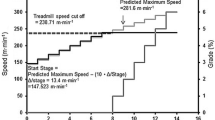Summary
An indirect test of maximal aerobic power (IMAP) was evaluated in 31 healthy male subjects by comparing it with a direct treadmill measurement of maximal aerobic power (\(\dot V\)O2 max), with the prediction of \(\dot V\)O2 max from heart rate during submaximal exercise on a cycle ergometer using åstrand's nomogram, with the British Army's Basic Fitness Test (BFT, a 2.4 km run performed in boots and trousers), and with a test of maximum anaerobic power. For the IMAP test, subjects pedalled on a cycle ergometer at 75 revs·min−1. The workload was 37.5 watts for the first minute, and was increased by 37.5 watts every minute until the subject could not continue. Time to exhaustion was recorded. Predicted \(\dot V\)O2 max and times for BFT and IMAP correlated significantly (p<0.001) with the direct \(\dot V\)O2 max: r=0.70, r=0.67 and r=0.79 respectively. The correlation between direct \(\dot V\)O2 max and the maximum anaerobic power test was significant (p<0.05) but lower, r=0.44. Although lactate levels after direct \(\dot V\)O2 max determination were significantly higher than those after the IMAP test, maximum heart rates were not significantly different. Submaximal \(\dot V\)O2 values measured during the IMAP test yielded a regression equation relating \(\dot V\)O2 max and pedalling time. When individual values for direct and predicted \(\dot V\)O2 max and times for BFT and IMAP were compared with equivalent standards, the percentages of subjects able to exceed the standard were 100, 65, 87, and 87 respectively. These data demonstrate that the IMAP test provides a valid estimate of \(\dot V\)O2 max and indicate that it may be a practical test for establishing that an individual meets a minimum standard.
Similar content being viewed by others
References
Amor AF, Savill MW (1973) The calibration of bicycle ergometers. Tech Memo. APRE 45/73. Army Personnel Research Establishment, Farnborough, Hants
åstrand I (1960) Aerobic work capacity in men and women with special reference to age. Acta Physiol Scand 49 [Suppl 169]
åstrand P-O, Ryhming I (1954) A nomogram for calculation of aerobic capacity (physical fitness) from pulse rate during submaximal work. J Appl Physiol 7: 218–221
åstrand P-O, Rodahl K (1977) Textbook of work physiology, 2 edn. McGraw-Hill, New York, p 355
Cooper KH (1968) A means of assessing maximal oxygen uptake. J Am Med Assoc 203: 201–204
Davies CTM (1968) Limitations to the prediction of maximum oxygen intake from cardiac frequency measurements. J Appl Physiol 24: 700–706
Davies CTM (1971) Human power output in exercise of short duration in relation to body size and composition. Ergonomics 14: 245–256
Froelicher CF Jr, Brammel H, Davis G, Noguera I, Stewart A, Lancaster MC (1974) A comparison of three treadmill exercise protocols. J Appl Physiol 36: 720–725
Glassford RG, Baycroft GHY, Sedgwick AW, Macnab RBJ (1965) Comparison of maximal oxygen uptake values determined by predicted and actual methods. J Appl Physiol 20: 509–513
Haisman MF (1970) The assessment of body fat content in young men from measurements of body density and skinfold thickness. Hum Biol 42: 679–688
Harwood AG (1981) Aerobic power, ischaemic heart disease risk factors and running performance in male personnel aged 35–49 years. Report 81R004. Army Personnel Research Establishment Farnborough, Hants
Hermansen L, Saltin B (1969) Oxygen uptake during treadmill and bicycle exercise. J Appl Physiol 26: 31–37
Kitagawa K, Suzuki M, Miyashita M (1980) Anaerobic power output of young obese men: Comparison with non-obese men and the role of excess fat. Eur J Appl Physiol 43: 229–234
Margaria R, Aghemo P, Pinera Limas F (1975) A simple relation between performance in running and maximal aerobic power. J Appl Physiol 38: 351–352
Margaria R, Aghemo P, Rovelli E (1965) Indirect determination of maximal oxygen consumption in man. J Appl Physiol 20: 1070–1073
Margaria R, Aghemo P, Rovelli E (1966) Measurement of muscular power (anaerobic) in man. J Appl Physiol 21: 1662–1664
Maritz JS, Morrison JF, Strydom NB, Wyndham CH (1961) A practical method of testing an individual's maximum oxygen intake. Ergonomics 4: 97–122
Mitchell JH, Sproule BJ, Chapman CB (1958) The physiological meaning of the maximal oxygen intake test. J Clin Invest 37: 538–547
Myles WS, Brown TE, Pope JI (1980) A reassessment of a running test as a measure of cardio respiratory fitness. Ergonomics 23: 543–547
Rowell LB, Taylor HL, Wang Y (1964) Limitations to prediction of maximal oxygen intake. J Appl Physiol 19: 919–927
Shephard RJ (1977) Endurance fitness, 2nd edn. University of Toronto Press, Toronto, p 111
Taylor HL, Buskirk E, Henschel A (1955) Maximal oxygen intake as an objective measure of cardiorespiratory performance. J Appl Physiol 8: 73–80
Author information
Authors and Affiliations
Rights and permissions
About this article
Cite this article
Myles, W.S., Toft, R.J. A cycle ergometer test of maximal aerobic power. Europ. J. Appl. Physiol. 49, 121–129 (1982). https://doi.org/10.1007/BF00428970
Accepted:
Issue Date:
DOI: https://doi.org/10.1007/BF00428970




